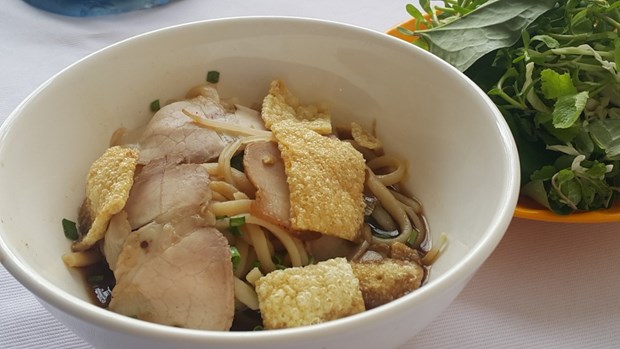It is considered a huge omission to miss out on trying “Mi Quang” and “Cao Lau” when visiting Hoi An since cuisine plays a crucial role in this city’s tradition.

A version of “Mi Quang” on Le Thi Hong Gam street, District 1, HCMC. The soup is a bit salty and rich of monosodium glutamate (MSG). MSG allergic consumers should be aware.
It
shouldn’t be like the literati Pham Quynh who mentioned nothing about the wide
variety of local foods in his book - “A
month living in the South of Vietnam”
“Mi
Quang” and “Cao Lau” haven’t been categorized in the same level until now when
they are both recognized as Asian culinary heritage. Mi Quang is a very homely
dish while Cao Lau is served in noble and wealthy families.
Mi
Quang is probably a localized version of a Chinese noodle dish brought to Hoi
An by merchants and traders from China. The noodle itself is made from rice
starch instead of flour as in the original.
Cao
Lau on the other hand pleased the Chinese merchants and living-abroad Japanese
with its flavors when Japanese buckwheat (Fagopyrum esculentum) – the
noodle-making component was not available. Thus, Quang Nam distinguished itself
from its 4 neighbor provinces by offering those two delicious signature dishes.
However,
nowadays, due to the unavailability of seasonal wheat, the noodles of these two
dishes no longer remain the elasticity unless they are made of Cambodian rice –
the chosen ingredient in several international cooking contests.
The fading Chashiu
“Cao Lau”
When
visiting Hoi An, the city magistrate – Ms. Bich Ha took us to the second best
Cao Lau restaurant named “Hai”. Chashiu here no longer preserves the
traditional Guangdong savor, even not as good as the Chashiu at a restaurant
located on Le Anh Xuan street, District 1 in Saigon.
The
Hoian-eses are also proud of their Ba Le well water used to soak rice along
with the ash from Cu Lao Chao burned woods. This one and only implementation is
the origination of Kobe beef. Except for the molecular gastronomy, no one knows
what are the components of Cu Lao Tram ash besides Ammonium Sulphate. As
recognized, water taken from Hoi An ancient wells has a remarkably delicious
taste.
Beside
Ba La ancient well, there is also Xom Cam well at Hon Lao Cu Lao Cham. We have
to accept the fact that Cham people are the expert in making wells. The chosen
ground-water streams never drain and always deliver a sweet and fresh taste
don’t matter how close to ocean they are such like Xom Cam well. In addition to
the stream selecting skills, Cham people also cover their wells’ bottom with a
layer of ironwood.
Thus,
a bowl of Cao Lau represents a complete local ecosystem including water from Ba
Le ancient well, ash from Cu Lam Cham and fresh vegies from Tra Que that is
nurtured by Co Co riverweed. Talking about this, my friend, Mr. The Hung would
be proud of himself for choosing Ms Bich Ha to be his guider.
A Mi Quang
encyclopedia
Noodle
restaurants in Da Nang are considered encyclopedias of “Mi Quang”. Although no
longer belonging to Quang Nam, Da Nang still preserves Mi Quang – the signature
dish.
In
the menu, we can see several types of Mi Quang including eel/blotched snakehead
(Channa manculata)/shrimp-pork-starfish/beef/pork
ribs/chicken/frog/assorted/special.
However,
people here often apply turmeric when marinating. We have tried many versions
of Mi Quang but cannot stand the strong scent of this yellowish spice. The
flavors are different from what our colleague’s wife, Ms. Huynh Hoa, who is
from Hoi An has cooked for us.
It
might be the most close-to-original Mi Quang that we have ever had. The soup
was prepared from shrimps, which generate the reddish color. You can relish Mi
Quang with pork and assorted vegies along with a slight aroma of chives and
peanuts oil.
Quang
Nam chilly cannot be missed when having Mi Quang. Starfish Mi Quang is
considerd to be the most delicious dish since starfish cannot be marinated with
turmeric.
The
common fact about these two Quang Binh signature dishes stays at how the soup
base is used as the mixing sauce at a very little amount. In other regions like
Saigon, these two dishes are served with a little bit more soup base.
(*) There
are 8 dishes that were served only to royal and high class including, nem cong
(peacock spring rolls), cha phuong (phoenix cakes), bear paws, deer tendons,
rhino skins, chimpanzee lips, elephant palms and bird’s nests.
By Ngu Yen/TGTT